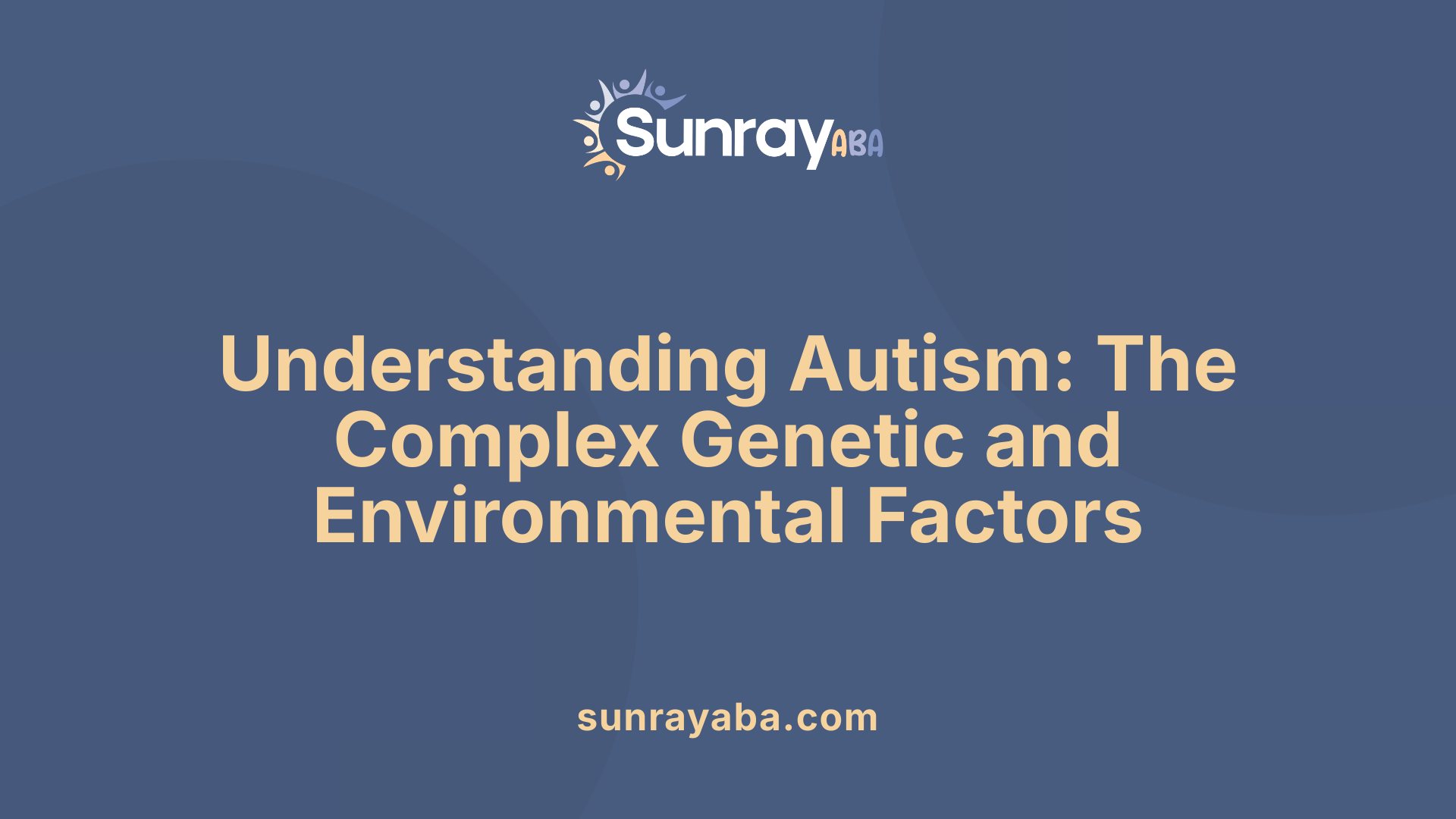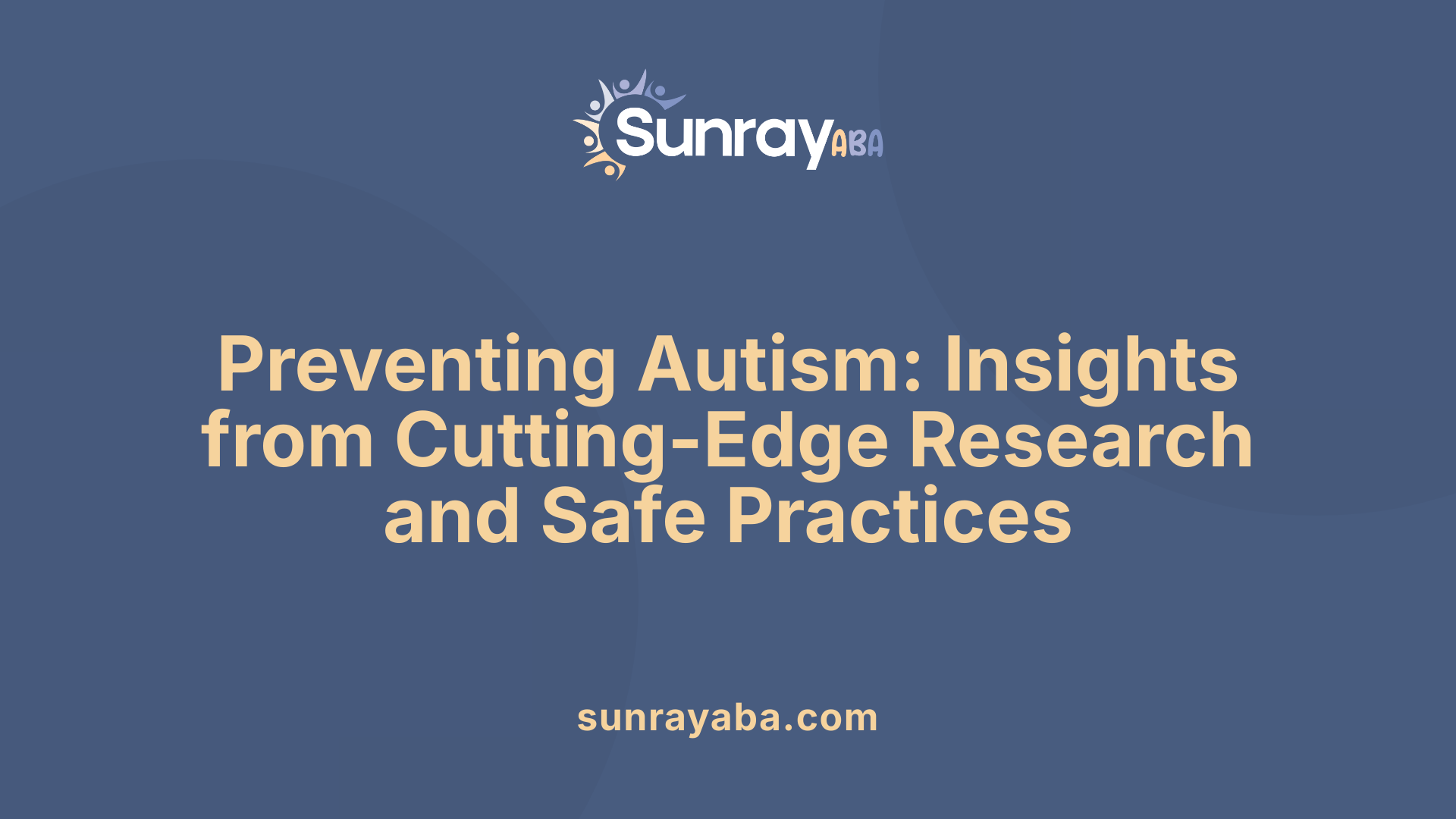How To Prevent Autism

Understanding Autism Spectrum Disorder and Prevention Approaches
Autism Spectrum Disorder (ASD) is a complex neurodevelopmental condition that affects communication, social interactions, and behavior, with signs often appearing by age 2. While its precise causes remain elusive, recent research emphasizes the importance of genetic, environmental, and maternal health factors. This article explores current understanding, preventive strategies during pregnancy, early detection, and ongoing research efforts aimed at reducing autism risk and supporting affected individuals.
Recognizing Early Signs of Autism in Young Children

What early signs and symptoms indicate autism spectrum disorder in young children?
Detecting autism early can lead to more effective support and intervention. Young children with autism often show specific developmental signs before the age of 3. These signs include delays in speech and language development. For example, some children may not babble by 12 months or have only a few words by 16 months. They might also struggle to use gestures, such as pointing or reaching, which are typical in early communication.
Another hallmark of autism is social interaction challenges. Children may avoid eye contact, show little or no social smiling, and seem unresponsive when their name is called by around 9 months. These behaviors suggest difficulties in social engagement and communication.
Repetitive behaviors and restricted interests are also common in early autism. Children might flaps of the hands, rock back and forth, or engage with toys in unusual ways. They may become intensely focused on specific objects or activities, restricting their range of interests.
Sensory sensitivities are frequently observed as well. Many children exhibit overreactions or underreactions to sounds, textures, lights, or smells—such as being distressed by certain noises or textures or seeking movement and sensory input excessively.
Early recognition of these signs is essential. If concerns arise, consulting a healthcare professional for screening can facilitate early diagnosis. Early intervention supports social, communication, and behavioral development, improving long-term outcomes for children with autism.
Genetic and Environmental Contributions to Autism Risk

What are the main causes of autism spectrum disorder?
Autism spectrum disorder (ASD) is caused by a combination of genetic and environmental factors that influence early brain development. Research shows that genetics play a significant role, with heritability estimates around 80%. Specific gene mutations and chromosomal syndromes such as fragile X syndrome and Rett syndrome are well-known genetic conditions associated with autism.
Genetic contributions include inherited DNA variations, mutations in specific genes affecting neuron communication, and gene networks that influence brain regional development. For example, autism tends to run in families, and having a sibling with ASD increases the likelihood of diagnosis.
Environmental influences during pregnancy also contribute substantially. These include maternal health issues like infections, immune disorders, obesity, and metabolic conditions such as diabetes. Exposure to pollutants like pesticides, heavy metals (e.g., lead and mercury), and air pollution—particularly traffic-related pollution—are linked to higher autism risk.
Additional factors include advanced parental age, especially paternal age over 34 years, which has been associated with increased risk. Birth complications, such as oxygen deprivation and extreme prematurity, further elevate the likelihood of ASD.
The interaction between these genetic susceptibilities and environmental exposures impacts early brain development, ultimately shaping the risk of autism. This complex interplay underscores the importance of both genetic screening and environmental management in efforts to prevent or reduce the incidence of ASD.
| Factor Type | Examples/Details | Impact on Autism Risk |
|---|---|---|
| Genetic Factors | Heritability (~80%), gene mutations, chromosomal syndromes (fragile X, Rett) | Strong influence, inherited traits, mutations affecting neural development |
| Environmental Factors | Pesticides, heavy metals, air pollution, maternal health issues | Significant impact during pregnancy and early life |
| Parental Factors | Older parental age (especially >34 years), birth complications | Increased risk through genetic mutations and perinatal stress |
Research continues to explore how these elements interact, aiming to better understand autism’s multifaceted origins.
Environmental Factors and Toxic Exposures that Influence Autism Risk

What are the environmental and genetic risk factors for autism?
Autism spectrum disorder (ASD) develops from an interplay of genetic and environmental factors. Approximately 60 to 90% of autism risk is linked to genetics, including inherited gene mutations and conditions like Rett syndrome or fragile X syndrome. These genetic changes can be passed from parents or occur de novo, adding to the complexity of autism's origins.
Environmental influences also play a significant role, especially during early brain development. Prenatal exposures such as maternal infections, metabolic disorders, bleeding, and exposure to certain medications—like valproic acid and some antidepressants—may interfere with the developing fetal brain. Studies have linked exposure to pesticides, heavy metals such as mercury and lead, and air pollution with increased autism risk.
Air pollution, particularly traffic-related pollutants, has been associated with neurodevelopmental impacts. Prenatal contact with pesticides and pollutants may induce genomic instability or epigenetic modifications—chemical changes that influence gene activity without altering DNA sequences. These modifications can affect critical aspects like neural communication and brain region connectivity.
Advanced parental age, especially paternal age over 34, shows a higher association with autism. This risk is thought to stem from increased chances of de novo mutations in sperm cells. Postnatal factors such as low birth weight, severe jaundice, or infections also heighten vulnerability by impacting neurodevelopment.
In summary, autism is primarily caused by complex interactions between genetic susceptibilities and environmental exposures. No single factor is solely responsible; instead, a combination of influences, especially during critical periods of brain development, can modify the likelihood of developing autism.
| Risk Factor Category | Examples | Notes |
|---|---|---|
| Genetic Factors | Family history, genetic syndromes | Inherited or spontaneous gene mutations |
| Prenatal Exposures | Pesticides, heavy metals, air pollution | Can alter DNA expression and brain development |
| Parental Age | Paternal age over 34 | Increased mutations in sperm |
| Postnatal Factors | Low birth weight, infections | Affect early neural growth |
| Medication Use | Valproic acid, certain antidepressants | May interfere with brain maturation |
Understanding these diverse factors highlights the importance of both genetic counseling and minimizing harmful exposures during pregnancy to reduce autism risks.
Scientific Research and Prevention Strategies

What does scientific research say about autism prevention?
Research in autism spectrum disorder (ASD) emphasizes a multifaceted approach to risk reduction, focusing on genetic, environmental, and early developmental factors. While no definitive way exists to prevent autism, studies highlight several strategies that can lower risk.
One significant factor involves prenatal care. Adequate nutrition before and during pregnancy—including supplementing with specifically bioavailable forms of folic acid—has been linked to a decreased likelihood of autism in children. Maternal health is crucial; managing conditions such as diabetes, immune disorders, and maintaining optimal weight can influence neurodevelopmental outcomes.
Avoiding environmental toxins is fundamental. Exposure to air pollution, pesticides, and chemicals during pregnancy has been associated with higher autism risk. Counseling and interventions aimed at reducing maternal exposure to these substances can be protective.
The importance of maternal metabolic health extends to proper iron levels, vitamin D status, and avoiding harmful medications like acetaminophen during pregnancy. Supplementing with omega-3 fatty acids and choline may also support fetal brain development and reduce risk.
Early diagnosis and intervention during preschool years are vital for improving outcomes. Behavioral therapies and supportive educational programs can significantly enhance social and communication skills.
Environmental biomarkers being studied for early diagnosis include air pollution levels, maternal immune responses, and metabolic markers. These insights help improve screening and potentially guide preventative measures.
In sum, while no single intervention guarantees prevention, adopting a comprehensive strategy—covering health management, environmental exposures, and early detection—can help mitigate risks associated with ASD. Lifelong support and early interventions remain central to optimizing quality of life for individuals affected by autism.
| Aspect | Influence | Additional Details |
|---|---|---|
| Biomarkers for early diagnosis | Helps identify at-risk infants | Includes air pollution, immune markers, metabolic profiles |
| Air pollution and traffic-related toxins | Increased exposure correlates with ASD | Prevention includes reducing exposure and environmental counseling |
| Maternal metabolic health and immune responses | Affects fetal neurodevelopment | Managing conditions like diabetes and autoimmunity is recommended |
| Role of prenatal vitamins and supplements | Reduces ASD risk | Folic acid, omega-3s, vitamin D, and choline are notable |
For further insights, you can explore the search term "scientific autism prevention research."
Early Diagnosis and Intervention Benefits
Why is screening at 18 and 24 months important?
Early detection of autism spectrum disorder (ASD) is crucial for maximizing developmental outcomes. The American Academy of Pediatrics recommends screening all children for autism at these ages because signs can be subtle and easily overlooked. Early screening allows healthcare providers to identify children who may need further assessment, such as delays in language skills or social interactions.
What are the early signs of autism?
Parents and caregivers should be vigilant for indicators like lack of gesturing, limited imitation, minimal eye contact, delays in speech, repetitive movements, or a strong focus on specific interests. Recognizing these signs early enables timely intervention, which can significantly influence the child's developmental trajectory.
How can play activities help in development?
Engaging infants in targeted play activities can support neural pathway development and improve social and communication skills. Activities such as imitation games, singing, following the baby's lead, and taking turns can be particularly beneficial. These interactions not only stimulate brain growth but also nurture emotional bonds and promote learning.
What are the benefits of early behavioral therapies?
Early behavioral interventions, including applied behavior analysis (ABA), speech therapy, and occupational therapy, are designed to improve communication, social skills, and behavioral regulation. Initiating these therapies by age 2 or 3 leverages the brain's plasticity, increasing the chances of substantial improvements.
How can early intervention help children with autism?
Early intervention strategies are vital because they support the child's learning and development during a critical period of brain growth. Tailored therapies can reduce behavioral challenges, enhance social engagement, and improve language skills.
| Aspect | Description | Additional Notes |
|---|---|---|
| Screening Age | 18 and 24 months | Recommended by AAP for early detection |
| Signs to Watch | Lack of gestures, limited imitation, delayed speech | Subtle but crucial cues |
| Play Activities | Imitation, singing, turn-taking | Stimulate neural pathways |
| Therapy Types | ABA, speech, occupational | Customized to child's needs |
| Outcomes | Improved communication, social skills, behavior | Higher likelihood of better prognosis |
Overall, conducting regular developmental screenings and engaging in early intervention programs can dramatically improve the quality of life for children with autism. These efforts help unlock their potential, promoting greater independence and social participation.
Support and Management Approaches for Individuals with Autism
What are effective management and support approaches for individuals with autism spectrum disorder?
Providing effective support for individuals with autism involves a mix of tailored therapies, educational strategies, and community involvement. Evidence-based behavioral therapies, such as applied behavior analysis (ABA), are widely used to help develop essential social, communication, and behavioral skills.
Speech and occupational therapies are critical in enhancing communication and daily living skills. These interventions are often complemented by social-relational approaches like DIR (Developmental, Individual differences, Relationship-based) or Floor Time, which focus on building relationships and emotional understanding.
School-based strategies play a significant role. Visual learning methods, like TEACCH (Treatment and Education of Autistic and Communication Handicapped Children), and the implementation of structured routines provide stability and promote learning.
Early diagnosis and consistent, multidisciplinary treatment plans are essential. Involving healthcare professionals ensures that medical or mental health issues co-occuring with autism are properly managed.
While there is no cure for autism, medications may be prescribed to manage specific symptoms such as anxiety, hyperactivity, or severe behavioral difficulties. The goal of interventions is to promote independence, dignity, and an improved quality of life.
Community support and advocacy are also vital. They help foster social integration and provide resources that can improve long-term outcomes. Regular review and adjustment of support strategies are necessary to meet evolving needs.
In conclusion, a personalized, comprehensive approach involving therapy, education, family support, and community resources forms the backbone of effective autism management.
Debunking Myths and Emphasizing Evidence-Based Facts
What are common myths and misconceptions about autism causes?
One widespread myth revolves around vaccines, especially the HPV and MMR vaccines, being responsible for autism. However, comprehensive scientific studies have consistently found no connection between vaccines and autism, dispelling this falsehood.
Another inaccurate belief is that autism results from poor parenting or neglect. Historically, the outdated "refrigerator mother" theory suggested cold or unloving mothers caused autism, but modern research shows that autism is a neurodevelopmental condition present from early in life, heavily influenced by genetic and neurological factors.
Many also mistakenly think autism is a mental illness or a contagious disease that can be cured. In reality, autism spectrum disorder (ASD) is a lifelong condition characterized by differences in brain development influencing communication and behavior. Supportive therapies can improve life quality, but there is no cure.
Misconceptions about environmental toxins, such as pesticides or chemical exposures, being direct causes of autism are also prevalent. While some environmental factors might influence risk, the primary causes are genetic, and current evidence does not conclusively link specific toxins to autism.
Overall, understanding that autism’s origins are complex, primarily genetic, and not caused by parenting or environmental toxins is crucial. Myth-busting helps reduce stigma and encourages informed support and intervention.
Towards a Holistic Approach to Autism Prevention and Support
Reducing the risk of autism involves a multifaceted approach that includes healthy prenatal practices, minimizing environmental toxicant exposures, early detection, and intervention. Ongoing research continues to deepen our understanding of gene-environment interactions, paving the way for more targeted preventative measures. Addressing misconceptions and promoting accurate information are vital in reducing stigma and supporting autistic individuals and their families. While there is no definitive way to prevent all cases of autism, fostering a healthy environment from conception through early childhood, coupled with early support and community resources, can significantly improve outcomes and quality of life for autistic individuals.
References
- Parental avoidance of toxic exposures could help prevent autism ...
- Autism spectrum disorder - Symptoms and causes - Mayo Clinic
- Can Autism Be Prevented? - WebMD
- Can we change the risk of autism? - PMC
- What causes autism? | Autism Speaks
- Autism | National Institute of Environmental Health Sciences
- Autism spectrum disorder - Diagnosis and treatment - Mayo Clinic
- 6 Early Autism Intervention Activities for Babies - Parents